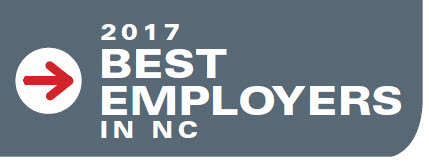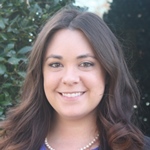 Bernard Robinson & Company ranks number one on the list of the Best Employers in North Carolina (small and medium sized companies) by Business North Carolina! Bernard Robinson & Company ranks number one on the list of the Best Employers in North Carolina (small and medium sized companies) by Business North Carolina!
Click
here
to learn more about why Bernard Robinson & Company is such a great place to work!

|
|
|
Celebrating 70 Years: My Journey to Bernard Robinson & Company
|
By Tim Hooks, CPA
Partner
I grew up without often following the mantra "look before you leap." I was a smart kid and trusted my gut instinct. What's the worst that could happen? Certainly I could figure it out along the way. Right! Right?
So, after breezing through high school, I attended Wake Forest in the fall of 1995. I quickly learned that perhaps I wasn't as smart as I thought. That was more than a little sobering for this 19-year-old, who let's just say was a little confident. After a needed reality check, I eventually found my way to accounting, and I was back in my comfort zone. It just made sense. Plus, I could graduate with a master's degree in five years, get out, and start making money. Sign me up! Finding a job back then with a degree from a school like Wake wasn't terribly difficult. I just had to decide who would be lucky enough to incur my services. Or so I thought...
Naturally I chose the "best" accounting firm at the time, Arthur Andersen ("AA"). The internship was a breeze, thus confirming my choice. Yes, I would take my talents to AA when I graduated. Little did I know in the year and a half before graduating (Spring 2000) that a company halfway across the country named Enron would greatly change my world and the accounting profession in general. I was given a nice letter assuring me that my offer was still good and I still had a job. I thought, "Great! How big of a deal could this really be?" Certainly nothing could stop the freight train to the top that I was on!
Within two years, AA was essentially shut down. Not exactly the best environment to be starting a career. In addition, I wasn't enjoying the work. I'm not your typical accountant (side note: while there are a few typical accountants, most of us are just like you). Working in AA's tax department, I'm not sure I met more than one of my clients in those first few years. While I'm not the life of the party, I am a natural extrovert. I really wanted (needed) to meet the people I was helping and to feel some sense of satisfaction in what I was doing. I was second guessing my career. For a kid that had historically followed his gut to mostly good choices, this was the closest I had come to a life crisis.
I was ready to give up my public accounting career when I had a conversation with a former fellow AA employee that had left a year earlier to join a small, local firm in Greensboro called Bernard Robinson & Company ("BRC"). He told me how great BRC was, how much he had learned, and how different the environment was. There was a true open door policy! The partners would sit down with you and teach you what you needed to know. So, trusting my friend and my gut, I decided to give it a shot.
It is now fifteen years later, and my friend was absolutely right! BRC has changed a lot since I started, growing from 35 to 130 people and from one office to three. The culture has surely changed a little over the years, but only a little. The people make the firm. We support each other in work and personal matters. We build relationships well beyond just co-workers. And we stay. There is very little turnover here, and in the accounting world, that's saying something.
A small, but very rewarding part of my role at BRC is recruiting. Every year I do my best to advise young adults ready to embark on their careers. In my experience, sometimes the best accounting firm is the local firm. The one that doesn't treat you like a number. The one that will personally invest in your future. The one that directly impacts the community you live in, by supporting the local non-profit community. The one that won't work you so hard that you want to leave after a few years or when you want to start a family. And the one that will likely be the most intrinsically rewarding as you will meet and get to know the people and businesses you are helping and see how your work directly impacts their lives.
|
 |
Like-Kind Exchange Pitfalls
|
 By Lory Kelley, CPA By Lory Kelley, CPA
Partner
Like-kind exchanges are a commonly used tool in the real estate world to defer gain by reinvesting sale proceeds into an investor's next promising deal. To successfully employ this strategy, the investor must follow strict guidelines without deviation. These guidelines include selecting qualified replacement property, adhering to timetables for identification and closing, and proper handling of sale proceeds, just to name a few. We regularly counsel our clients on the following like-kind exchange pitfalls:
Failure to Fully Reinvest:
An investor must not only reinvest the net proceeds realized from the sale of relinquished property, but must also replace the debt the investor was relieved of when the relinquished property was sold. Said another way, an investor must reinvest the full sale price less selling expenses of the relinquished property. Failure to do so will result in a dollar of gain recognition for every dollar not reinvested to the extent of the deferred gain. By not reinvesting the full amount, an investor can easily erase any savings created by completing a like-kind exchange in the first place.
Constructive Receipt:
To avoid income recognition, a taxpayer cannot take actual or constructive possession of sale proceeds. This requirement necessitates the involvement of a qualified intermediary or exchange company. The concept is straightforward, but related funds can innocently end up in the possession or constructive possession of the taxpayer. The following are just a few examples:
- A refund to the taxpayer of earnest money on an unsuitable potential replacement property before the full exchange is closed.
- If the taxpayer's attorney is acting as closing agent, the attorney as agent of the taxpayer will be in possession of the exchange funds in order to make disbursements from the closing.
- Payment of expenses out of the exchange account of costs that are not related to the disposition or acquisition of the properties involved in the exchange and that are not typically covered in local closing statement standards as the responsibility of the buyer or the seller.
Related Party Exchanges:
Generally, an investor may execute a like-kind exchange with a related party. If the related party in receipt of the exchanged property disposes of the property within two years of the initial transfer, the transaction does not qualify for tax-deferral treatment, and the investor will be required to recognize the income. Additionally, a like-kind exchange with a related party will not qualify for tax deferral treatment if the primary motive is tax avoidance. For example, a taxpayer enters into an exchange after selling low basis property to an outside person with a related party that has high basis property. The related party group as a whole is being enriched, and therefore such a transaction is considered to have a tax avoidance motive and is disallowed.
To avoid these and other pitfalls, and to learn more about like-kind exchanges, please consult your tax advisor.
|
Revenue Recognition Changes on the Horizon
|

By Nathaniel Jordan, CPA
Manager
In 2014, the Financial Accounting Standards Board (FASB) published Accounting Standards Update (ASU) 2014-09 - Revenue from Contracts with Customers (Topic 606). This standards update, which is effective for annual reporting periods beginning after December 15, 2017 for public entities and for annual reporting periods beginning after December 15, 2018 for nonpublic entities, was created to eliminate the differing guidance for varied transactions and industries under current GAAP and replace it with a more consistent framework for recognizing revenue. FASB's goal in developing this framework was to eliminate inconsistences in how revenue is recognized, make revenue recognition practices more comparable across industries, and enhance disclosures to provide more useful information to financial statement users.
As part of achieving FASB's stated principle of "[recognizing] revenue to depict the transfer of promised goods or services to customers in an amount that reflects the consideration to which the entity expects to be entitled in exchange for those goods or services," all entities affected by ASU 2014-09 will follow a 5 step approach when recognizing revenue:
- Identify the contract (an agreement between two or more parties that creates enforceable rights and obligations) with a customer
- Identify the performance obligations (a promise to transfer a good or service to the customer) in the contract
- Determine the transaction price (the amount of consideration to which an entity expects to be entitled in exchange for transferring promised goods or services)
- Allocate the transaction price to the performance obligations in the contract (dividing up consideration among obligations based on the costs of the obligations)
- Recognize revenue when (or as) the entity satisfies a performance obligation (booking the revenue)
In addition to performing these steps, entities under ASU 2014-09 must also include updated disclosures in their financial statements to provide qualitative and quantitative information about revenue from contracts with customers. These disclosures include, but are not limited to, information about revenue recognized from contracts with customers, determination of transaction price, allocation of transaction price to performance obligations, and judgments about the timing of satisfaction of performance obligations.
For more information on the effect that ASU 2014-09 will have on your business, and to allow sufficient time to plan for these changes, please consult your CPA.
|
 |
To Prepare Direct Method Cash Flow or Not to Prepare Direct Method Cash Flow...That is the Question
|

By Jennilee Richard, CPA
Manager
With the implementation of ASU 2016-14 (Not-for-Profit Entities) looming, it is important to begin discussing the types of reporting changes you can expect to see with your accountant. One possible change relates to the statement of cash flows. Not-for-profit entities will have the option of presenting either indirect method or direct method cash flows. The change with ASU 2016-14 is that if the direct method is selected, the indirect reconciliation will no longer be required.
You may be thinking to yourself, "who would ever willingly choose to present direct method cash flows?" I don't blame you; when most accountants hear the phrase "direct method cash flow statement," they cringe. While a statement of cash flows using the direct method can be a bear to prepare, there are significant benefits to the reader of the financial statements. This presentation can be especially helpful when communicating financial information to boards of not-for-profits or to groups of individuals who do not have a financial background.
The purpose of a statement of cash flows is simple: to give information on how cash came in and what it was spent on during the year. However, when you think about a traditional statement of cash flows using the indirect method, the bulk of the section for changes in operating activities deals with variances in balance sheet accounts year over year. To the untrained eye, this information can seem completely meaningless and unhelpful. On the other hand, the primary benefit of the direct method presentation is that the operating activities section very clearly shows cash collected from customers, cash payments to employees for services, cash payments for supplies, etc. This can be more beneficial than looking at revenues and expenses on the statement of activities, as that statement will also include the effects of current and prior year accruals. The direct method presentation of operating cash flows may be more beneficial to board members, grantors, and the general public to have a clear picture of how cash came in and went out during the year.
Before determining which method of cash flow statements to present upon adopting ASU 2016-14, it would be beneficial to discuss the matter internally with management, with your board, and with other stakeholders of your not-for-profit organization to ensure the method selected will represent the most useful method for everyone. If you have questions about the methods, the cost of implementing a change, or any other aspects of adopting ASU 2016-14, please talk to your accounting professionals.
|
|
|
Bernard Robinson & Company, LLP | (336) 294-4494 |
[email protected] |
1501 Highwoods Blvd, Ste 300
Greensboro, NC 27410
|
|
BRC Strategy is designed to provide information of a general nature and is not intended as a substitute for professional consultation and advice. The opinions and interpretations expressed should not be construed or used as legal or tax advice, written or otherwise, and cannot be used for the purpose of avoiding any penalties that may be imposed under federal, state or local law.
|
|
|
|
|
Copyright © 2015. All Rights Reserved.
|
|
|
|